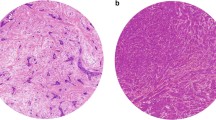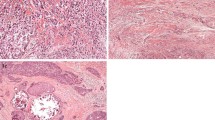Abstract
The tumor-stroma ratio has previously been shown to be prognostic for patients with invasive breast cancer. We present a validation study to assess the prognostic significance in lymph node-negative, premenopausal patients from the perioperative chemotherapy trial (POP trial, 10854) conducted by the European Organization for Research and Treatment of Cancer. The POP trial assessed the efficacy of one course of perioperative chemotherapy (consisting of fluorouracil, doxorubicin, and cyclophosphamide). Hematoxylin and eosin (H&E) stained sections were retrieved from a subset of premenopausal, node-negative patients from this trial and were scored for the percentage of intra-tumoral stroma. The tumor-stroma ratio was associated with disease-free survival in univariate and multivariate analysis. Tumors with a high tumor-stroma ratio had an increased hazard of 1.853 for disease relapse (95 %CI 1.327–2.585, P < 0.001) independent of other parameters. Combining other parameters with the tumor-stroma ratio improved risk stratification. For triple-negative tumors, the tumor-stroma ratio was associated with an increased hazard for disease relapse, independent of other parameters (HR 2.711, 95 %CI 1.111–6.614, P = 0.028). The tumor-stroma ratio was also independently associated with locoregional recurrence even in breast cancer patients ≤40 years of age (HR 2.201, 95 %CI 1.038–4.669, P = 0.040). This study validates the prognostic value of the tumor-stroma ratio. This parameter can be easily assessed on HE slides and can be implemented next to pathological staging reports to determine patient prognosis.




Similar content being viewed by others
Abbreviations
- H&E:
-
Hematoxylin and eosin
- ER:
-
Estrogen receptor
- PgR:
-
Progesterone receptor
- HER2:
-
Human epidermal growth factor receptor 2
- MVD:
-
Microvessel density
- DFS:
-
Disease-free survival
- OS:
-
Overall survival
- LRR:
-
Locoregional recurrence
- EORTC:
-
European organization for research and treatment of cancer
- TGF-β:
-
Transforming growth factor-β
- CD:
-
Cluster of differentiation
- MMP:
-
Matrix metalloproteinase
- ECM:
-
Extracellular matrix
- HR:
-
Hazard ratio 95 %CI, 95 % confidence interval
- DCIS:
-
Ductal carcinoma in situ
- LCIS:
-
Lobular carcinoma in situ
References
Bombonati A, Sgroi DC (2011) The molecular pathology of breast cancer progression. J Pathol 223:307–317
Pietras K, Ostman A (2010) Hallmarks of cancer: interactions with the tumor stroma. Exp Cell Res 316:1324–1331
Ma XJ, Dahiya S, Richardson E, Erlander M, Sgroi DC (2009) Gene expression profiling of the tumor microenvironment during breast cancer progression. Breast Cancer Res 11:R7
Troester MA, Lee MH, Carter M, Fan C, Cowan DW, Perez ER, Pirone JR, Perou CM, Jerry DJ, Schneider SS (2009) Activation of host wound responses in breast cancer microenvironment. Clin Cancer Res 15:7020–7028
Beck AH, Sangoi AR, Leung S, Marinelli RJ, Nielsen TO, van de Vijver MJ, West RB, van de Rijn M, Koller D (2011) Systematic analysis of breast cancer morphology uncovers stromal features associated with survival. Sci Transl Med. doi:10.1126/scitranslmed.3002564
de Kruijf EM, van Nes JG, van de Velde CJ, Putter H, Smit VT, Liefers GJ, Kuppen PJ, Tollenaar RA, Mesker WE (2011) Tumor-stroma ratio in the primary tumor is a prognostic factor in early breast cancer patients, especially in triple-negative carcinoma patients. Breast Cancer Res Treat 125:687–696
Mesker WE, Liefers GJ, Junggeburt JM, van Pelt GW, Alberici P, Kuppen PJ, Miranda NF, van Leeuwen KA, Morreau H, Szuhai K, Tollenaar RA, Tanke HJ (2009) Presence of a high amount of stroma and downregulation of SMAD4 predict for worse survival for stage I–II colon cancer patients. Cell Oncol 31:169–178
Courrech Staal EF, Wouters MW, van Sandick JW, Takkenberg MM, Smit VT, Junggeburt JM, Spitzer-Naaykens JM, Karsten T, Hartgrink HH, Mesker WE, Tollenaar RA (2010) The stromal part of adenocarcinomas of the oesophagus: does it conceal targets for therapy? Eur J Cancer 46:720–728
Clahsen PC, van de Velde CJ, Julien JP, Floiras JL, Delozier T, Mignolet FY, Sahmoud TM (1996) Improved local control and disease-free survival after perioperative chemotherapy for early-stage breast cancer. A European Organization for Research and Treatment of Cancer Breast Cancer Cooperative Group Study. J Clin Oncol 14:745–753
Altman DG, McShane LM, Sauerbrei W, Taube SE (2012) Reporting recommendations for tumor marker prognostic studies (REMARK): explanation and elaboration. BMC Med 10:51
McShane LM, Altman DG, Sauerbrei W, Taube SE, Gion M, Clark GM (2006) REporting recommendations for tumor MARKer prognostic studies (REMARK). Breast Cancer Res Treat 100:229–235
Clahsen PC, van de Velde CJ, Duval C, Pallud C, Mandard AM, Delobelle-Deroide A, van den Broek L, Sahmoud TM, van de Vijver MJ (1998) p53 protein accumulation and response to adjuvant chemotherapy in premenopausal women with node-negative early breast cancer. J Clin Oncol 16:470–479
van de Vijver MJ, Peterse JL, Mooi WJ, Wisman P, Lomans J, Dalesio O, Nusse R (1988) Neu-protein overexpression in breast cancer. Association with comedo-type ductal carcinoma in situ and limited prognostic value in stage II breast cancer. N Engl J Med 319:1239–1245
van der Hage JA, van den Broek LJ, Legrand C, Clahsen PC, Bosch CJ, Robanus-Maandag EC, van de Velde CJ, van de Vijver MJ (2004) Overexpression of P70 S6 kinase protein is associated with increased risk of locoregional recurrence in node-negative premenopausal early breast cancer patients. Br J Cancer 90:1543–1550
Dvorak HF (1986) Tumors: wounds that do not heal. Similarities between tumor stroma generation and wound healing. N Engl J Med 315:1650–1659
Chang HY, Nuyten DS, Sneddon JB, Hastie T, Tibshirani R, Sorlie T, Dai H, He YD, van’t Veer LJ, Bartelink H, van de Rijn M, Brown PO, van de Vijver MJ (2005) Robustness, scalability, and integration of a wound-response gene expression signature in predicting breast cancer survival. Proc Natl Acad Sci U S A 102:3738–3743
Finak G, Bertos N, Pepin F, Sadekova S, Souleimanova M, Zhao H, Chen H, Omeroglu G, Meterissian S, Omeroglu A, Hallett M, Park M (2008) Stromal gene expression predicts clinical outcome in breast cancer. Nat Med 14:518–527
Beck AH, Espinosa I, Gilks CB, van de Rijn M, West RB (2008) The fibromatosis signature defines a robust stromal response in breast carcinoma. Lab Invest 88:591–601
Witkiewicz AK, Dasgupta A, Sotgia F, Mercier I, Pestell RG, Sabel M, Kleer CG, Brody JR, Lisanti MP (2009) An absence of stromal caveolin-1 expression predicts early tumor recurrence and poor clinical outcome in human breast cancers. Am J Pathol 174:2023–2034
Kim HS, Kim GY, Kim YW, Park YK, Song JY, Lim SJ (2010) Stromal CD10 expression and relationship to the E-cadherin/beta-catenin complex in breast carcinoma. Histopathology 56:708–719
Carter CL, Allen C (1989) Henson DE: relation of tumor size, lymph node status, and survival in 24, 740 breast cancer cases. Cancer 63:181–187
Elledge RM, McGuire WL (1993) Prognostic factors and therapeutic decisions in axillary node-negative breast cancer. Annu Rev Med 44:201–210
Sternlicht MD, Lochter A, Sympson CJ, Huey B, Rougier JP, Gray JW, Pinkel D, Bissell MJ, Werb Z (1999) The stromal proteinase MMP3/stromelysin-1 promotes mammary carcinogenesis. Cell 98:137–146
Thomasset N, Lochter A, Sympson CJ, Lund LR, Williams DR, Behrendtsen O, Werb Z, Bissell MJ (1998) Expression of autoactivated stromelysin-1 in mammary glands of transgenic mice leads to a reactive stroma during early development. Am J Pathol 153:457–467
de Kruijf EM, Dekker TJ, Hawinkels LJ, Putter H, Smit VT, Kroep JR, Kuppen PJ, van de Velde CJ, Ten DP, Tollenaar RA, Mesker WE (2012) The prognostic role of TGF-beta signaling pathway in breast cancer patients. Ann Oncol 24(2):384–390
Roman-Perez E, Casbas-Hernandez P, Pirone JR, Rein J, Carey LA, Lubet RA, Mani SA, Amos KD, Troester MA (2012) Gene expression in extratumoral microenvironment predicts clinical outcome in breast cancer patients. Breast Cancer Res 14:R51
Loeffler M, Kruger JA, Niethammer AG, Reisfeld RA (2006) Targeting tumor-associated fibroblasts improves cancer chemotherapy by increasing intratumoral drug uptake. J Clin Invest 116:1955–1962
Farmer P, Bonnefoi H, Anderle P, Cameron D, Wirapati P, Becette V, Andre S, Piccart M, Campone M, Brain E, Macgrogan G, Petit T, Jassem J, Bibeau F, Blot E, Bogaerts J, Aguet M, Bergh J, Iggo R, Delorenzi M (2009) A stroma-related gene signature predicts resistance to neoadjuvant chemotherapy in breast cancer. Nat Med 15:68–74
Camp JT, Elloumi F, Roman-Perez E, Rein J, Stewart DA, Harrell JC, Perou CM, Troester MA (2011) Interactions with fibroblasts are distinct in Basal-like and luminal breast cancers. Mol Cancer Res 9:3–13
Anderson SJ, Wapnir I, Dignam JJ, Fisher B, Mamounas EP, Jeong JH, Geyer CE Jr, Wickerham DL, Costantino JP, Wolmark N (2009) Prognosis after ipsilateral breast tumor recurrence and locoregional recurrences in patients treated by breast-conserving therapy in five National Surgical Adjuvant Breast and Bowel Project protocols of node-negative breast cancer. J Clin Oncol 27:2466–2473
Elkhuizen PH, van Slooten HJ, Clahsen PC, Hermans J, van de Velde CJ, van den Broek LC, van den Vijver MJ (2000) High local recurrence risk after breast-conserving therapy in node-negative premenopausal breast cancer patients is greatly reduced by one course of perioperative chemotherapy: a European Organization for Research and Treatment of Cancer Breast Cancer Cooperative Group Study. J Clin Oncol 18:1075–1083
Elkhuizen PH, Voogd AC, van den Broek LC, Tan IT, van Houwelingen HC, Leer JW, van den Vijver MJ (1999) Risk factors for local recurrence after breast-conserving therapy for invasive carcinomas: a case-control study of histological factors and alterations in oncogene expression. Int J Radiat Oncol Biol Phys 45:73–83
Mamounas EP, Tang G, Fisher B, Paik S, Shak S, Costantino JP, Watson D, Geyer CE Jr, Wickerham DL, Wolmark N (2010) Association between the 21-gene recurrence score assay and risk of locoregional recurrence in node-negative, estrogen receptor-positive breast cancer: results from NSABP B-14 and NSABP B-20. J Clin Oncol 28:1677–1683
Acknowledgments
The tumor material that was used for the analysis in this study was collected as part of a trial by the EORTC. We, therefore, gratefully acknowledge the EORTC, the enrolled patients, and investigators at local centers who collected the material.
Conflict of interests
The authors report no conflicts of interests.
Author information
Authors and Affiliations
Corresponding author
Additional information
C. J. H. van de Velde, Principal investigator EORTC trial 10854 (POP trial).
Rights and permissions
About this article
Cite this article
Dekker, T.J.A., van de Velde, C.J.H., van Pelt, G.W. et al. Prognostic significance of the tumor-stroma ratio: validation study in node-negative premenopausal breast cancer patients from the EORTC perioperative chemotherapy (POP) trial (10854). Breast Cancer Res Treat 139, 371–379 (2013). https://doi.org/10.1007/s10549-013-2571-5
Received:
Accepted:
Published:
Issue Date:
DOI: https://doi.org/10.1007/s10549-013-2571-5




